North Sails Expert Tom Davis lays out your Inventory Options
For some sailors, “club racing” means a casual jib-and-main evening race aboard a well-stocked cruising boat carrying roller furlers and its anchor and chain in the bow. For others, it means a no-holds-barred weekend race aboard a Melges 32 with a full crew aboard.
While there’s no single answer to the question,”What sails are best for club racing?” most club racers will fit into what we call the “cross-over cruiser” category, so that will be our main focus in this article. If you are a cross-over cruiser, you want to race your boat close to home, but you also want a sail inventory suited to sailing with your family and friends during the day and periodically heading out for a weekend or a week’s cruise.
If you want to compete at any level, there are a few things we would recommend prioritizing long before you ever think about choosing the right sails. For example, if you haven’t cleaned your bottom, no sail inventory in the world will overcome a field of grass on the bottom. Second, get the boat set up with the mast straight and reasonably tuned, with your jib leads in position, etc. Maybe look at installing a folding propellor, too. Then it’s time to think about the sails.
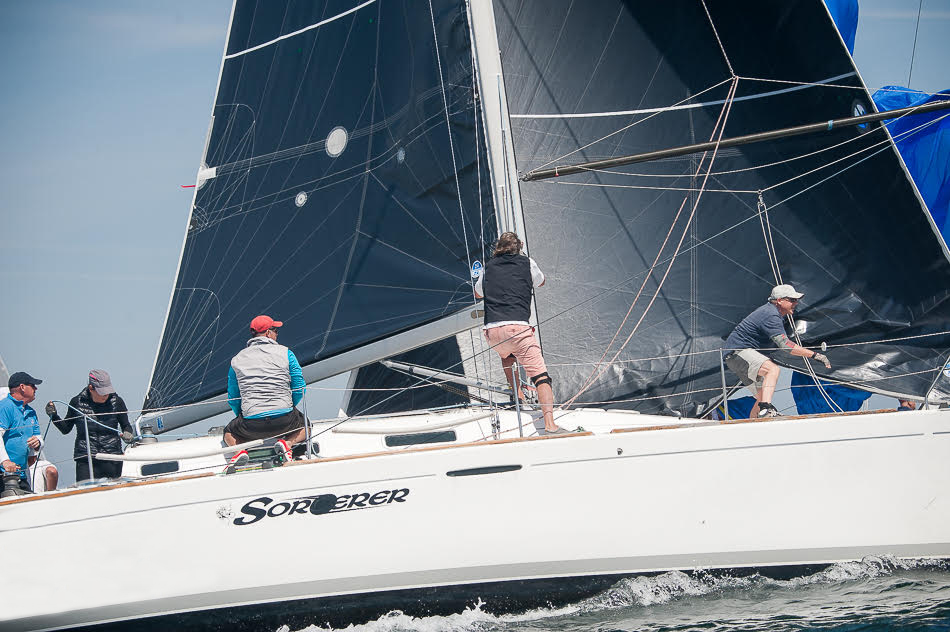
What size should your sails be?
Sail size is dictated very much by your type of boat and rig design. Some masts are designed and positioned for large genoa headsails and smaller mains, while others have the opposite. But you often have some choices to make on size as well.
Most club racing is scored under PHRF or another handicap system requiring that you declare your sail sizes. If that’s the case in your area, do you really know your genoa’s LP (luff perpendicular) and your mainsail girth measurements? And if so, have they been reported correctly to your handicappers? Our experience is that many casual racers find mistakes on their certificates when they take a close look, and we suggest you talk to your sailmaker; that genoa you may have thought was a 150-percent LP sail may only be a 135 and your rating is penalizing you unfairly.
Next, think about whether new sails either larger or smaller might make a significant difference in your speed or rating. If you feel your boat is chronically underpowered in the predominant conditions, a bigger sail might help you gain power. If you are often overpowered, maybe you have an opportunity to use a smaller genoa, tip over less, and get a more favorable rating.
You may be able to make some smaller gains with your mainsail. If the sail is smaller than recorded in its girth—the measurements from luff to leech at different heights—you may be entitled to a few seconds per mile of rating benefit. In general, the girths that became standard a number of years ago under the IMS rating rule are still the norm for PHRF. IMS girth mains hit a sweet spot with a nice-sized roach for extra power but not so much that the sail hangs up on the backstay in light-air jibes. Work with a sailmaker to be sure you’ve got what PHRF allows in your area, but don’t push the roach too far as that usually carries a hefty penalty.
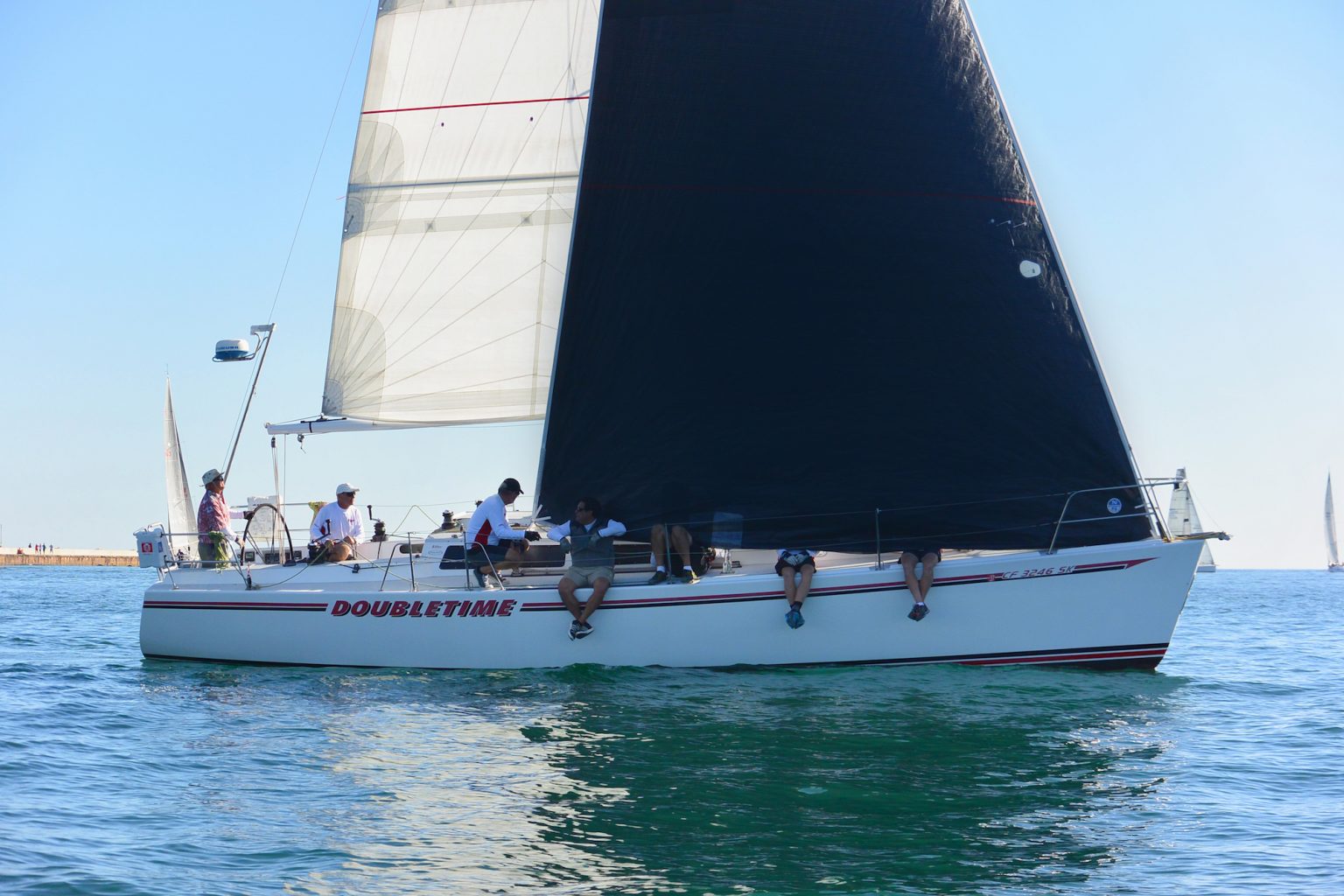
What’s the best sail shape?
Again, this is a broad question, and for most club racers, we recommend starting by simply identifying the shapes of your current sails. The best tool for this is a camera, with photos taken from as low as you can get, positioned mid-foot looking upwards. Share this with your sailmaker who can readily advise on the condition of your sail shape.
If your sailmaker isn’t interested in looking at your photos, you probably have the wrong sailmaker to help you get into club racing. No sailmaker can work miracles with a really tired sail through recutting, but sometimes with a little recut or stiffer battens you can breath some extra life into some old sails.
What we often see with older sails is that the shapes become distorted as the material ages. Often, the overall draft moves too far aft. In addition, the leech profile typically changes by “opening up” in the high load middle and upper sections, at which point the whole sail becomes less efficient (aka slower!). That’s a good time to consider putting yourself on a plan to budget a new sail every now and then, starting with the worst one—probably the genoa that you use the most. Every season, take the same sail shape photos again to monitor what’s happening and compare it to your plan.
On most boats, having a good all-purpose headsail of maximum size (for your rating) with nice shape is your single most important sail. A mainsail with mediocre shape that is paired with a nice headsail is usually a better upwind combination than the other way around.
Downwind, the shapes of your main and headsail matter less than their total area. And as soon as you turn the corner to go back upwind, the shape of the genoa is most important.
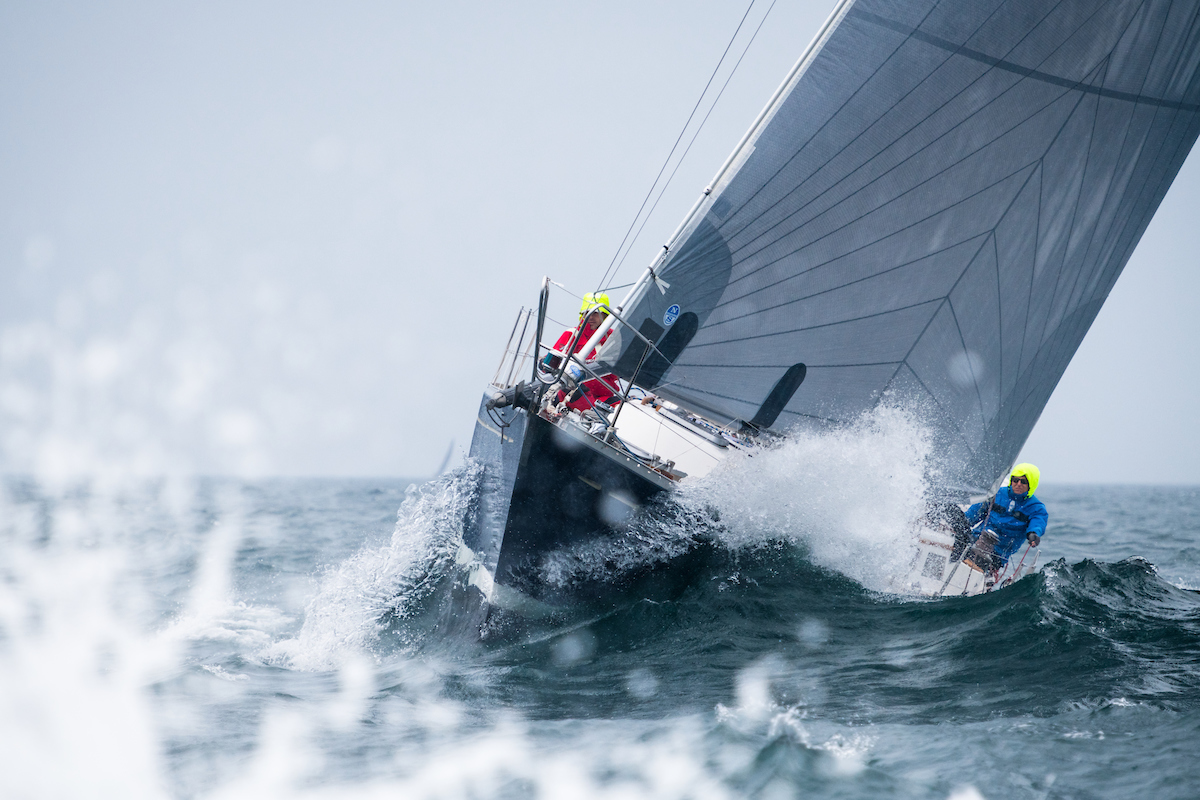
What’s the right sail in terms of a molded shape for your boat?
It’s a good idea to work with a sailmaker who is experienced in building sails of the right shape for your boat. The ideal mold shape for a boat of heavier displacement is different than on a newer, lighter, more modern boat. This is true for both spinnakers and upwind sails. Finding a sailmaker with a library of sail shapes to call on will make a difference.
Your sailmaker should also know your local conditions; for example, when you’re racing, is the race usually held late in the day and the wind is dying off, or is it breezy all the time?
Another factor is that older boats tend to have overlapping headsails. That should influence the decision of the material chosen for the sail, or at the very least how you can extend the life of sails being dragged across spreader ends and around the rig in tacking. Genoa sail materials often need to be different than those in non-overlapping jibs, and a good sailmaker will be able to address that with a mix of materials.
A flattish mold shape for a medium heavy No. 1 genoa is not going to be the ideal shape for a boat with a lot of displacement and an overlapping genoa . Boats like these slow down a lot if you try to point too much, especially on a light air Wednesday night racecourse. If you’re racing on weekends in higher average breezes, a flatter sail may be exactly right.
Another consideration is whether you want two sails. You may want to use a roller-furling/UV-protected genoa for casual club racing and cruising, then bend on your better “race” sail for the weekend races in regional fleets. And if you use a roller-furling sail exclusively, check to see if PHRF in your area will give you a rating credit for it.
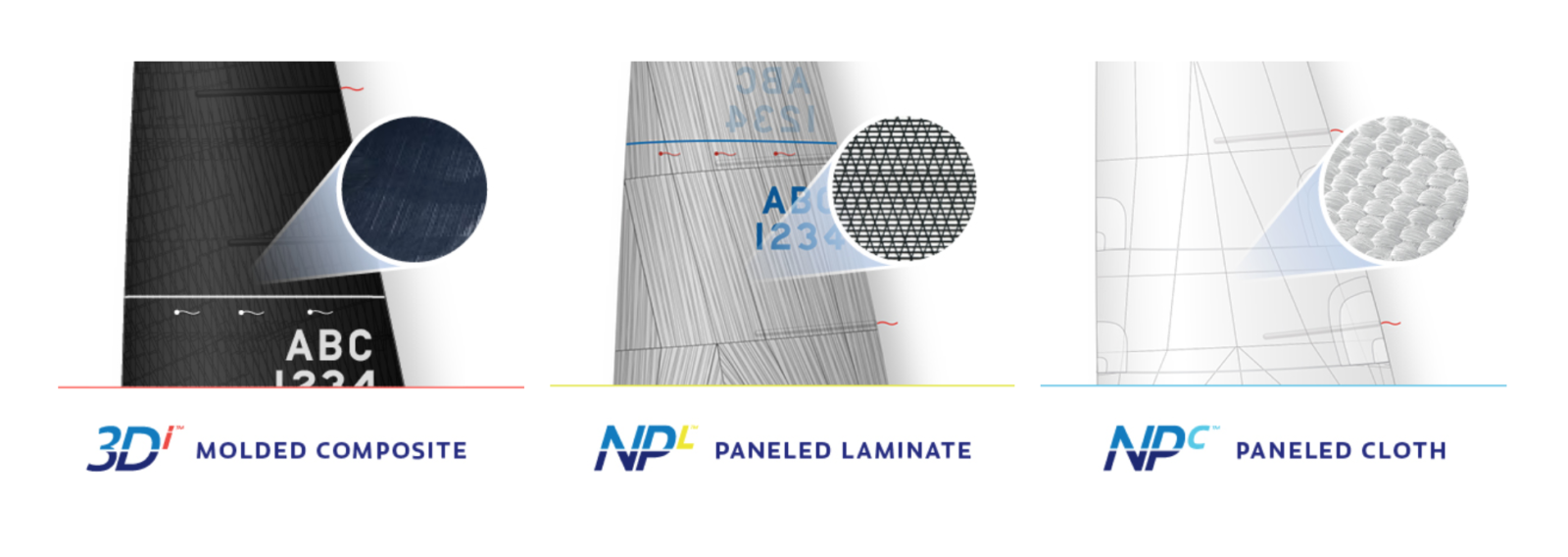
What’s the right material group to look at?
The sail materials you choose will depend on your needs and budget. All else being equal, woven Dacron sails for a boat with a small mainsail and roller-furling genoa configuration will be disadvantaged compared to others. If your budget is modest and you have a desire for practically carefree sails that will last a really long time, it’s a perfectly good choice, but be aware you’ll struggle to compete against any racing boats with higher performance sail inventories, particularly as the sails age and shapes deteriorate.
However, for smaller boats, Dacron can stay close in performance. The loads on a 34-foot club racer are moderate enough that an owner might be very happy with sails made by North of Radian Dacron, a patented single-ply woven sailcloth with stretch performance like a warp-oriented polyester laminate. It is a true “Dacron” sailcloth that enables radial panel layouts which map to loads more efficiently than horizontal panels can, while still providing classic Dacron reliability.
However, a slightly larger boat of 35 to 45 feet will be more loaded up and if you care whether you’re a minute ahead or a minute behind at the end of a long beat, you’ll likely want higher-performance laminated sails, if not 3Di.
The next level up is sails made from laminated cloth, often in a radial layout. Nearly all sailmakers make these sails, which incorporate to some extent a laminated film that is more fragile than fiber and has a tendency to shrink, which affects sail shape subtly. Within the North line, the paneled laminate sail is typically a moderate-priced product, has moderate durability and its performance is enhanced, but not state of the art. Shape durability is much better than classic Dacron but not as high as North’s 3D materials. The toughness of these sails is quite high.
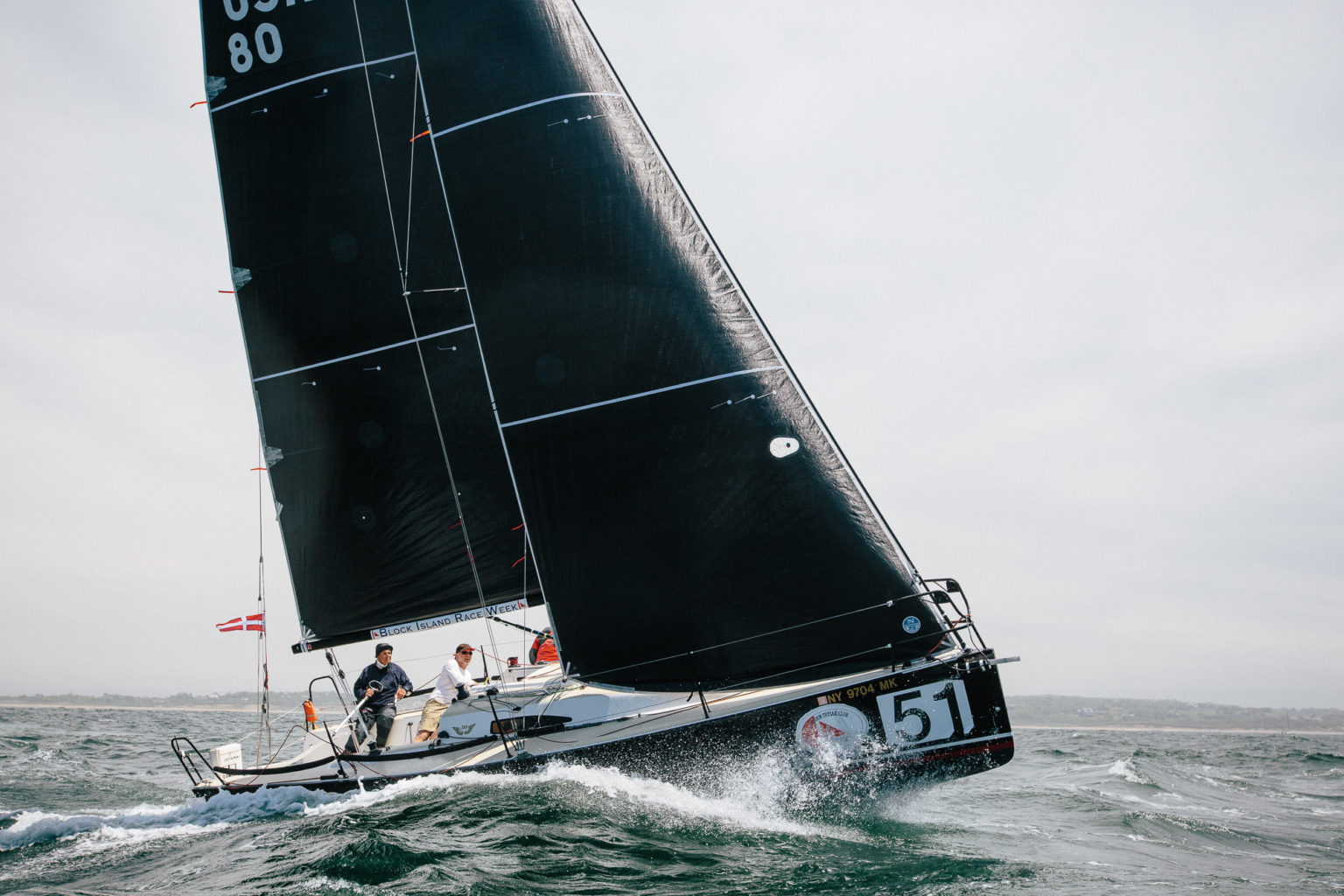
Many sailmakers make what are often referred to as “string” sails, which are made by gluing spaced-apart yarns between flat outer layers of film in multiple sections—sometimes with additional outer taffeta plies for toughness, or non-woven skins that look similar to North’s 3Di. These horizontal sections are later assembled with added broad-seaming to induce shape. The yarn pattern is intended to follow the predicted loads in the assembled sail.
North Sails’ predecessor to 3Di was 3DL (no longer in production), which was different from current string/membrane sails in that 3DL sails were produced in one piece on a full scale adjustable mold, configured to the exact desired foil shape. This eliminated overlapping seams, and maintained the continuous integrity of each yarn pass. But 3DL did share one of the less-desirable features of string/membrane sails—thermoplastic “hot melt” glue. We discontinued 3DL in favor of 3Di because 3Di answers all the problematic issues: thermoset cross-linked resin system for superb material durability, true molded construction for optimum flying shape, elimination of overlapping seams, etc.
North’s proprietary molded 3Di product is still relatively new, but has begun to prove itself with durability that is unheard of in other types of sails, both in terms of material and shape stability. The 3Di is a thermoset resin system; unlike the film and adhesive used in “string sails,” 3Di is not affected by heat and moisture over time. It has a high ratio of fiber to resin, and the thermoset system is extremely rugged and environmentally stable. The product costs more to produce and prices reflect that.
For a club racer, choosing among these options comes down to being clear-eyed about the level of sail performance that’s a sensible match for the kind of boat you have, the kind of fleet you’re racing in, and your level of commitment and expectation to try to win races rather than simply going out to enjoy participating. If you really are looking to be at the front of the pack, you’ll need an equivalent level of products to get you around the course.
The choice used to come down to whether you wanted durability or a great mold shape. With 3Di, it’s more about the up-front cost versus the durability you gain in terms of material that’s at least as good and has better sail shape over time.
Last year, North made the option of choosing 3Di more attractive at the club level with the introduction of a 3Di product called 360. It is targeted at the club racer and is made using polyester, Dyneema and aramid. It’s not cheap but it has a pretty competitive price given all of the other benefits of 3Di. And of course you get the same shape contribution from North’s top designers.
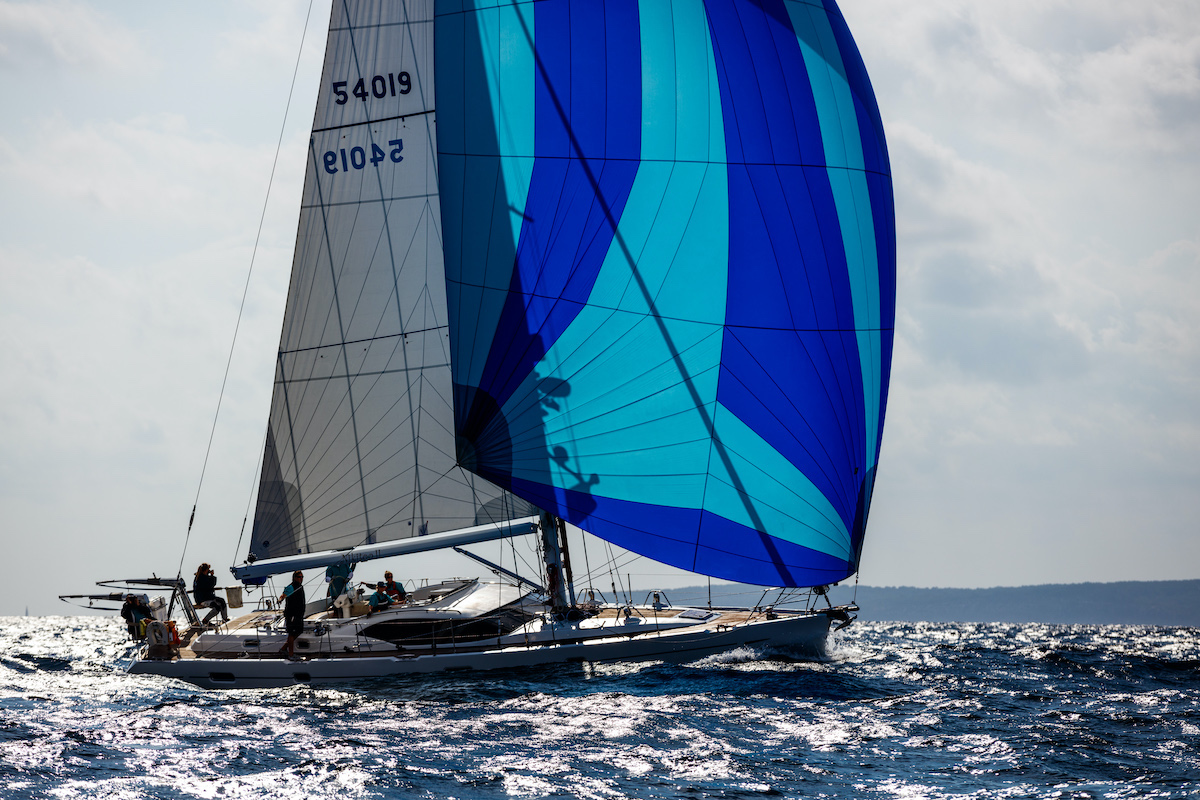
What are the best downwind sails for club racing?
There is a huge difference in spinnakers you might use for club racing, starting with the difference between asymmetrical and symmetrical sails, also known as A sails and S sails. For all but the most casual club races, a cruising asymmetric spinnaker tacked to your bow will not make you fully competitive, but if you have a centerline bowsprit or pole mounted at the bow, an A sail may work well. If you have a traditional spinnaker pole, you’ll likely do best with an S sail.
Working with a sailmaker with access to a big library of design shapes can make the choice of spinnaker type, size and shape easier. And if you’re likely to fly an A sail, you’ll certainly need to discuss this with your sailmaker. The shape development in A sails has been dramatic over the last 20 years, and you’ll also want to talk about different sizes that suit your sailing area. Do you need an A1, A1.5, and/or A2 and should the sail be tipped toward running deep, more all-purpose, or reaching?
What’s the best spinnaker material?
Even more important for club racing is your choice of material. Spinnaker nylons come in two groups, and the first is cruising preg, which has melamine resin in the fibers but is not coated. If you can live with a heavier sail that flies well, this classic .75-ounce nylon is still a very nice, tough material with low porosity. As a bonus, it will still feel good after you drop it overboard once or twice. North Sails’ NorLon is an example of this cloth, available in three-quarter ounce and one-and-a-half ounce weights, as well as 2 and 3-plus ounce weights for bigger boat spinnakers.
Compared to NorLon and other classic nylons, the newer, higher-performance nylons have a lighter thread density and therefore lighter weight, but they also have urethane coatings, which stabilize the cloth. Over time, they break down and lose performance.
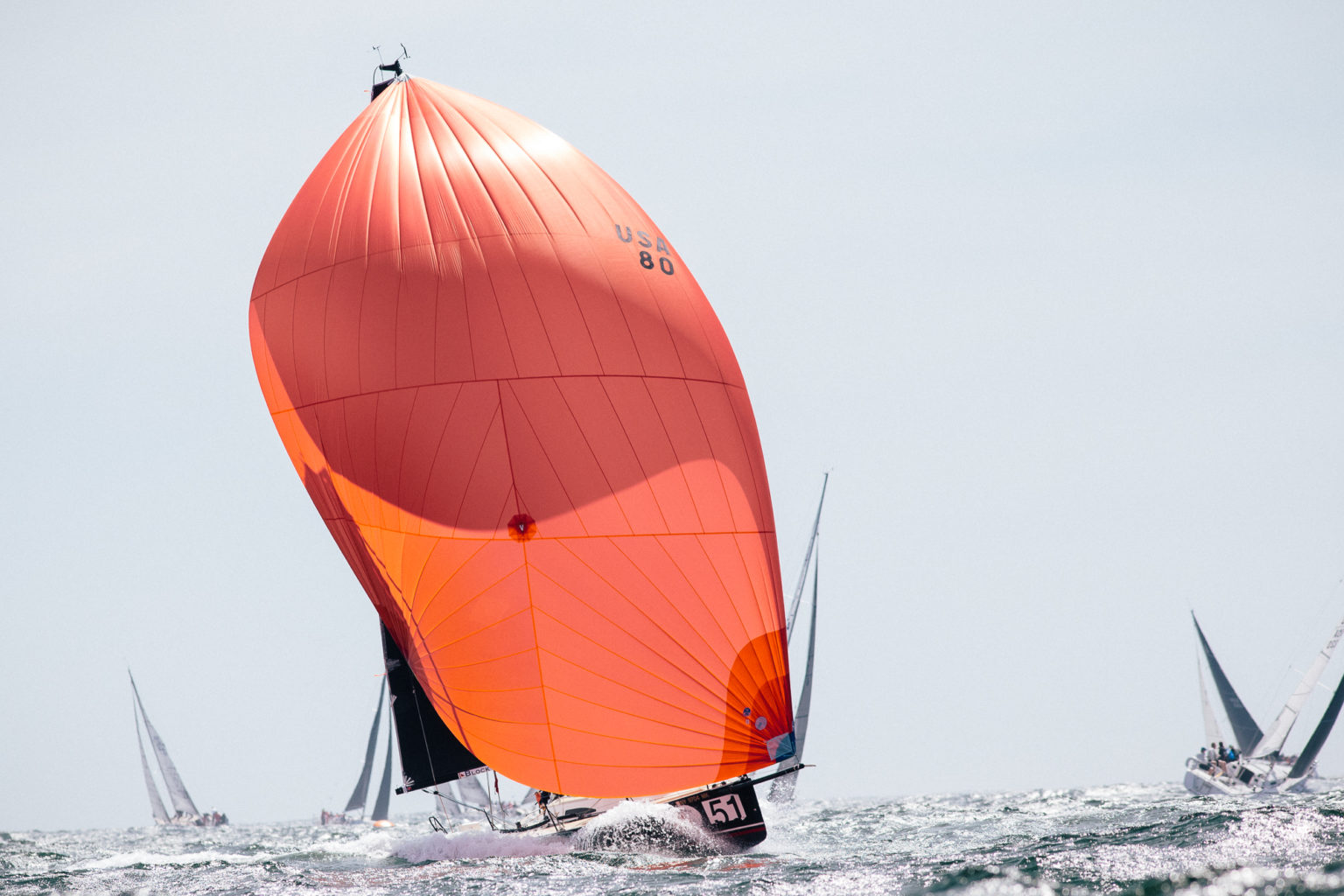
These higher-performance nylons have pregged fibers plus a surface urethane coating, allowing you to fly a sail with a less dense weave, saving weight without affecting porosity. They have a higher price and break down faster, but you get a sail cloth that weighs 35-40 grams per square meter instead of close to 50.
Bainbridge International’s AirX cloth is one example. It is both pregged and coated and a little nervous in how it flies and it’s less forgiving, but it’s a great cloth for use on boats that sail higher angles downwind. Contender’s SuperKote cloth is also pregged and coated, but is a little softer on bias and more elastic than AirX. This makes it better for boats that reach less and sail deeper angles on the run.
If you are a club racer and want to buy one spinnaker, you’ll likely want an all-purpose (AP) sail, either asymmetric or symmetric, made with a nylon like NorLon that is pregged but not coated. Unlike with upwind sails, you can remain competitive in many conditions with a sail like this.
If you are racing in some higher-level fleets, though, you may want two spinnakers. The first could be an AP spinnaker for when the breeze is on, made with a good .75-oz material in a nicely shaped sail. But for nights in a dying breeze, you’ll have an advantage if you have a lighter-weight A or S sail.
Take for example our Melges 32, a fast, modern lightweight boat. If there’s a good breeze, we pick the A2, which is an asymmetrical AP runner. We choose the A1 for Vmg sailing in a dying breeze because it’s actually smaller and therefore better for sailing more aggressive jibing angles, especially as it gets lighter.
Learn more at: https://www.spinsheet.com/north-sails-resources




